Thanks gang! These are the ones Rider included in the list:
SI-B8UZ91B20WW Samsung F-Series Gen3 100W FB24B double row led strip 3500K
Is that too old school? I haven't researched yet to know if they're LM561C or not. They already have like 3 model numbers in that description! I'm completely new to this part of the game

.
[here's the list from Rider in total if anyone has suggestions:
Digikey.com
SI-B8UZ91B20WW Samsung F-Series Gen3 100W FB24B double row led strip 3500K
3 x $48.07 = $144.21
Onlinecomponents.com
Mean Well HLG-320H-48A 320W LED driver
1 x $84.10 = $84.10
Figure about $50 in miscellaneous stuff to assemble. You'll end up with way more light and better coverage.
This design is working with the de facto standard of 35W per square foot for leds.
These components play really well together and return about 95% efficiency.
You'd need 12' of 1.5x1x0.125 Al u-channel, some thermal tape (which I can send you),
a standard 15A male cord plug, and some wire and wire nuts to put it all together.
No soldering required. There are lots of ways to make a single fixture. I chose to use all-thread just because it was easy.]
Stay away from the double row strips, the single row strips requires more heatsink but you get a lot higher efficiency, and you can't run the double row strips as hard and the spread/flexibility is compromised.
The 1120mm (4') single row F-series strips are all right, but a bitch to work with and you won't really save anything over going with the 560mm strips.
However, I highly recommend the H inFlux strips, L04 or L06 in 3000K, but note that 4000K is as efficient as 5000K in the same series with a lot more red in the mix.
Digi-key is full of weird dead-ends, but you can find the actual units with a little effort and their parametric search function.
This is the H inFlux catalogue, so you can filter the different units, use only CCT and size/dimension to find what you need.
The 41mm W are double row, the 24mm W are single row and come in two types with different amounts of diodes - hence the different max currents and prices.
And ye olde F-series.
I think 6 of the 560mm strips would be fine for your needs, whether it's single row F-series or H inFlux L04 or L06.
There's also the Bridgelux EB2 strips, or the Vesta strips that have 2 row of different CCT diodes.
This is worth a read
DIY LED Strip Build Designs for Samsung H-Series, F-Series, Q-Series, and Bridgelux EB Gen.2 - LED Gardener
Definitely bluer. Is 3500K a better start-to-finish than 3000K, particularly since my plants live outside during daylight hours?
Let me explain my grow to see if it helps. Every morning the plants go into the sun. During veg, every evening they go in the shed under the lights. When I decide to flip my photos, they go into the shed for 12 hours of darkness. So I'm waiting for my autos to finish (so I can get them max light 20/4) before I convert the shed to dark at night and flip the photos. During the winter I try not to run autos while I'm flowering photos.
What that means practically is that only autos will be flowered under these lights. The only time the photos will be under them during flower is if it's cloudy or raining. During veg, everything is under the lights at night.
Does that change any decisions about color temp?
Confused?
No, get 3000K!
The higher the CCT, the higher the electrical efficiency.
The lower the CCT, the higher the photosynthetical efficiency.
AKA the redder the better

Since the difference in electrical efficiency between the different CCT's is low when using high end Middle Power Diodes.
3500K is a WORSE start to finish than 3000K, you sacrifice red for blue, or in reality a few hours shorter veg for less bulk and potency

Don't believe the shit Kind spews out to increase sales, it's just BS based on loose assumptions and non-comparative studies from the 70's...
Kind is just Mars Hydro in an Iphone cover, and the electrical efficiency is the same as HID, complete and utter garbage

Try asking them why they put yellow and green monodiodes in their lamps if they're not good for plants

The mixed spectrum from most blurples is around 2700K, it's not some magical spectrum engineers spent countless hours tweaking just right, it's a handful of crappy components and a lot of marketing...
Watt for watt the PPFD willl be higher from high end white light LEDs, even the super cheap Citizen 1212 COBs will kill Kind and the other blurples.
The yellow/orange/green spectrum is a big part of the sun's output and plants do use these wavelenghts for both photosynthesis and for signalling the plant to do certain things, we've only scratched the surface of the science of plants and light and most of the stuff found online is commercial content.
Green wavelenghts will signal lower growth to strecth for light, and it's the wavelength that penetrates the canopy and the primary provider of photosynthesis for leaves/flowers in the shade.
 . Looks like I'm kinda back in the middle of the spectrum.
. Looks like I'm kinda back in the middle of the spectrum.




 .
.
 . I'll go through the links tomorrow at work and take notes on what I find.
. I'll go through the links tomorrow at work and take notes on what I find. 

 Also keep in mind that 12 hours of tropical sun every day would probably not be a good thing.
Also keep in mind that 12 hours of tropical sun every day would probably not be a good thing.